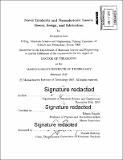Novel terahertz and nanophotonic lasers : theory, design, and fabrication
Author(s)
Lee, Jeong-Won
DownloadFull printable version (11.11Mb)
Other Contributors
Massachusetts Institute of Technology. Department of Materials Science and Engineering.
Advisor
Marin Soljac̆ić.
Terms of use
Metadata
Show full item recordAbstract
In this thesis, we will explore numerical modeling and fabrication of laser sources. First, we demonstrate and distinguish experimentally the existence of special type of Fano resonances at k~~0 in a macroscopic two-dimensional photonic crystal slab. We fabricate a square lattice array of holes in silicon nitride layer and perform an angular resolved spectral analysis of the various Fano resonances. We elucidate their radiation behavior using temporal coupled-mode theory and symmetry considerations. The unique simplicity of this system whereby an ultra-long lifetime delocalized electromagnetic field can exist above the surface and consequently easily interact with added matter, provides exciting new opportunities for the study of light and matter interaction. However, we confirmed that achievable quality factor (Q) is limited by fabrication imperfection. Therefore, in the second part, we present an extensive fabrication optimization process, through which we established improved Q by a factor of three. Lastly, we report a comprehensive theoretical analysis and new experimental data of high-pressure (> 1 Torr) lasing action in optically-pumped far-infrared (OPFIR) lasers. No previous models could satisfactorily capture high-pressure operation because of the growing role of excited vibrational levels. Without these additional excited vibrational levels, molecules are artificially trapped in lower energy vibrational levels. This, in turn, prematurely triggers the so-called vibrational bottleneck and quenches the lasing action at low pressures in the previous models. Even though the high-pressure behavior can be more realistically modeled by including numerous excited vibrational levels, it would dramatically increase the computation time, and more importantly, the rate constants connecting all these levels are unknown. We propose a new model with an expandable pool which embodies 120 excited vibrational levels. Moreover, the knowledge of state-to-state rates among the excited vibrational levels is unnecessary in the proposed new model since the net rate related to the expandable level can be found by equilibrium conditions. Together with a detailed calculation of the pump rate and the wall collision rate, our model qualitatively and quantitatively reproduces experimentally measured high-pressure behavior. The model can be universally used for any OPFIR gas laser system. Thus, our work puts forward a theoretical formalism that could enable the advancement of compact terahertz radiation sources.
Description
Thesis: Ph. D., Massachusetts Institute of Technology, Department of Materials Science and Engineering, 2015. Cataloged from PDF version of thesis. Includes bibliographical references (pages 101-106).
Date issued
2015Department
Massachusetts Institute of Technology. Department of Materials Science and EngineeringPublisher
Massachusetts Institute of Technology
Keywords
Materials Science and Engineering.